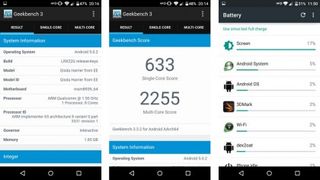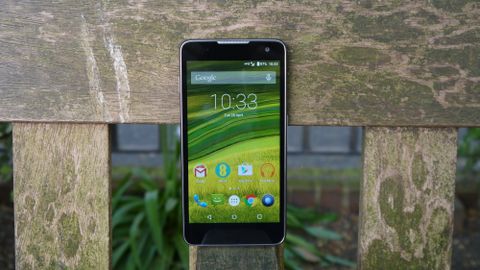Why you can trust TechRadar
Performance
While many lower-priced smartphones source Mediatek processors, EE doesn't cut corners with the Harrier, which packs a 64-bit octa-core Qualcomm 615 processor that runs at up to 1.5GHz (four 1.5GHz and four 1GHz cores).
Paired with 2GB of RAM, the Harrier doesn't ever feel sluggish and happily runs modern games thanks to the Adreno 405 GPU. It's the same processor found in the HTC Desire 820 and Oppo R5, though both handsets are around £100 more expensive than the Harrier.
This newer octa-core processor will help the Harrier squeeze out extra battery life compared to older quad-core models, and certainly means that the 2,500mAh should easily last a day's use.

To give an indication of how the Harrier compares to other handsets, I installed Futuremark's 3D Mark Ice Storm Extreme benchmark, which completed with an admirable score of 5,389, which actually comes out lower than older phones based on the Cortex A7 architecture.
Next I ran the all-encompassing GeekBench 3 benchmark, which awarded the Harrier a single-core score of 633 and a multi-core score of 2,255. Again, these results are not as high as some older phones, which I suspect is due to the lower clock speeds of the 615's eight Cortex-A53 cores.
Despite the average benchmark scores, overall I was very impressed with the Harrier's performance and stability in all of the apps I tried, it's certainly the most powerful phone around for under £200 and even seems good value alongside the highly praised OnePlus One.
Battery life
Although it may not be the largest capacity on the market, the 2,500mAh non-removable lithium-ion cell inside the Harrier from EE is actually only 500mAh less than the Samsung Galaxy S6, which is currently considered cream of the smartphone crop.
To give the battery a proper workout, I ran TechRadar's tried-and-tested HD video for 90 minutes with the brightness turned up to full.
Over the course of the test, the battery dropped from 100% down to 78%. This 22% drop was actually quite impressive and shows that the lower-clocked cores of the Qualcomm's 64-bit CPU are doing an admirable job of power-saving.

Battery life easily surpassed 24 hours, even with regular use of the camera, social apps and the odd bit of light gaming. When streaming a HD movie, over six hours of playback is easily achievable – better than some considerably pricier phones can provide.
Should you want to stretch out the battery life even further, there are options to fiddle with in the Smart Connectivity settings menu. This menu allows you to set off-peak times when data connections are disabled, or an even more aggressive power saving mode that disables data when the screen is turned off.
Current page: Performance and battery life
Prev Page Features and interface Next Page The essentials and camera
Vodafone wants to help UK SMBs get more productive than ever before

Nikon Z 40mm f/2 review: this cheap, modern 'nifty forty' has been my every day lens for over a year and it hasn't let me down

Could ChatGPT be the next big cybersecurity worry — researchers say it can crack systems faster than ever before
